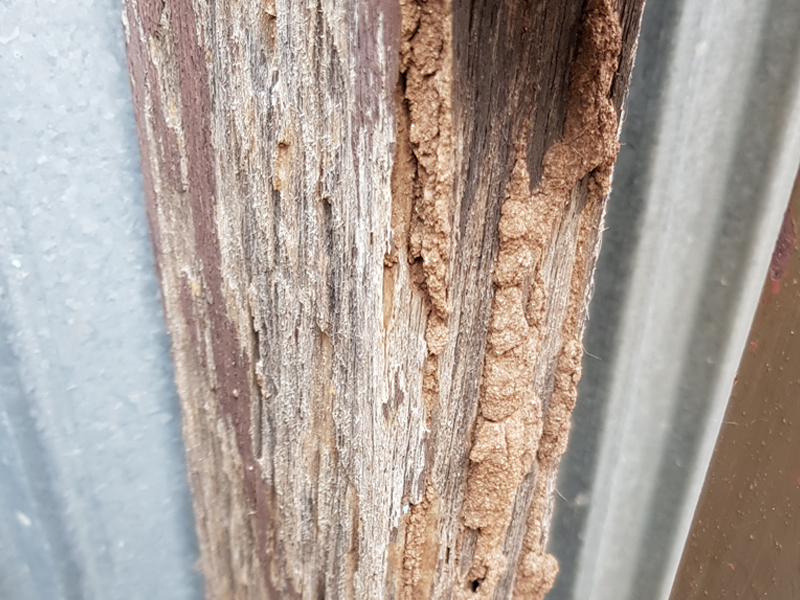Pest Inspections Adelaide. Feel confident knowing that your property and family are free from dangerous pests!
If you’re buying or selling a property, you want to know you have made the right decision. While a building inspection is standard practice prior to purchase, we also highly recommend a thorough pest inspection.
While some people may think a building inspection will include looking for pests, it is important to note how different these processes are. Building inspections may only look for visual signs of damage or decay caused by pests. While a pest inspection directly looks for pests that are active in the structure of the building such as fungi, termites, mould and boring insects.
Pest inspections aim to catch the pest and prevent any further damage. Smart Choice Building & Pest Inspections also search anywhere up to 30 metres from the structure to look for any nearby threats, ensuring the future safety of your property.

Craig Foster, Owner/Inspector.
Pest Inspection in Adelaide
Are you concerned about an infestation in your house? Are you looking to purchase a new building but aren’t sure of just how well protected they are against a pest infestation? Then you need to get in touch with us. We can help you with your Pest Inspection anywhere in Adelaide. We help you protect your homes and businesses against pests.
We have years of knowledge, experience, and training as pest control technicians, and we can help you identify all kinds of pest infestations as well as a strategy on how to deal with them.
Contact us today to inquire about our comprehensive and tailored pest inspection service in Adelaide. We understand that pest problems can cause significant issues for both homeowners and business owners to solve which we can help you with your pest inspection needs, including identification, origins, and we can discuss with you your removal options, prevention, in a minimally invasive way.
Ours is a fully licensed, insured, and certified inspector operating at the leading edge of safe and effective pest control services that utilize the latest in pest inspection technology. We are better equipped to safeguard you, your family, customers, and employees from any harmful effects of having pests in your house, and we can help keep things from getting out of control.

Termites
If you notice tiny holes on your wooden items with some wooden powder or notice entire wooden chambers crumbling, then you might have a termite infestation. Termites are a perennial pest in Adelaide that requires constant vigilance. Our termite inspection and control techniques can prove very useful in treating and eradicating termite infestations in your home, home, shed, office, warehouse, factory, or any other place where there might be wood. Also, please be aware that until you get your inspection done, try to isolate the infested items from the rest of the house (if possible) or the infestation will only grow, we do not recommend attempting any DIY solutions, as the problem could exacerbate in untrained hands. Give our qualified and experienced pest inspectors a call.

Bee and Wasp Control
While bees serve a vital role in the ecosystem, Wasps are just nuisances. Especially if you have kids, you would be well advised to address the problem as quickly as possible. However, neither bees nor wasps commonly build nests in an easy-to-spot location, so you might need to hire a professional to help you find the nest. We can help you with that. We can help relocate bees if need be.

Rats and Mice
Other common pests in Australia are rats and mice. They are quite common in older homes. On top of being prolific breeders capable of reaching massive numbers in a very short period, mice are also capable of chewing through PVC, electrical wiring, they frequently end up shorting circuits and causing unaccountable damage, not to mention they are quite disease-ridden as well. We can help you ensure the safe removal of mice and rats by sending one of our qualified pest inspection specialists anywhere in Adelaide.

Cockroaches
Cockroaches are the one kind of pests that find their way just about anywhere in Adelaide, and they are quite persistent to boot. For an untrained individual, it might be next to impossible to identify the source of the infestation, and even if they are located and rooted out in one place, they could easily relocate to another part of your property. You need to have it professionally inspected so we can help you identify where they are and also all the places they could run off to ensuring you have every opportunity to ensure that they don’t return.

Possum
Possums are a protected species in Australia, however, despite being marsupials, they have been known to take up residence in people’s homes, or businesses. They are generally considered docile, and non-aggressive, so they are unlikely to attack your pets. They prefer to avoid confrontations, which is why many of them flee from predators and attackers into urban dwellings. If you suspect a possum infestation, you can rely on us to help you with the matter. We use controlled techniques to find any possums that might be in your home or business, and if you want, we can arrange for them to be safely returned to their natural environment, unharmed.
How we work
Whether it is for your current home, business, or perhaps a property you hope to acquire, it is a viable strategy to ensure there are no pest infestations at the property. The last thing you want is to move in your precious family heirlooms only to lose them to termites. You can count on us to run a pre-purchase pest inspection to help bring you peace of mind. Our team is highly trained, very experienced, and knows the latest techniques using the latest tools to carry out pest inspections, all our services are carried out by licensed professionals.
1 in 3 australian homes!!!
In a recent study the CSIRO found that 1 in 3 Australian homes have some level of termite occupation. The state of South Australia is seems is perfect for this insatiable pest.
What Do Our Pest Inspections Cover?
Our detailed pest inspections search for the presence of recent pest activity in all areas of the property including all rooms, fences, trees, sheds, roof, basements and out buildings. We use state of the art equipment to seek out pests such as moisture meters to ensure that no stone is left unturned. SC Building Inspections strictly follows the Australian Standards for Timber Pests (3600 2).

Interior
- All Walls
- Window Frames
- Skirting Boards
- Door Frames
- Floorboards
Exterior
- All Walls
- Door Frames
- Pergolas / Verandahs
- Window Frames
- Decks
Property
- Up to 30m of house and within boundaries of property
- Retaining Walls
- Garages, Carports and Sheds
- Fences
- Trees and gardens
Sub-Floor Space
- Floor boards
- Beams
- Slabs
- Bearers
- Stumps
Roof Space
- Roof frame
- Wall Plates
Roof Exterior
- Fascia
- Barges
Common Pest Inspection Questions
Why are termites such a problem?
There have been instances where houses have required demolition because the structural damage was so severe.
- The most common types of termite damage are:
- Degradation to all timberwork – structural as well as interior timbers
- Damage to floor joists and bearers
- Damage to roof and structural timbers
- Electrical issues, including shorts and fires
Even if these issues may seem minor, each can have a domino effect resulting in major damage. If loadbearing or crucial structures are impacted more serious consequences can include roof, floor or wall collapse, electrical fires.
Why do pest inspections take so long?
We pride ourselves on providing a detailed pest inspection to give you peace of mind.
When booking your service please discuss your preferred timeframes with us.
Is having just a pest inspection enough?
To be as thorough as possible Smart Choice Building & Pest Inspections always recommends you have both a building and pest inspection. Essentially the two types of inspections are looking for different issues. Pest inspections look directly for problem pests within and outside the building structure while building inspections only look for visual signs of damage and decay that can be caused by non-pest factors.
By deploying a targeted search for problem pests you can potentially save yourself the drama and cost of future damage caused by active pests as well as be alerted to other potential problems in your property.
How can I guard against pest-related property damage?
Ensure any firewood and rubbish isn’t stored closed to your home.
Watch for signs of dying trees and shrubs and remove them from your property as soon as possible.
Don’t allow trees and shrubs to come in contact with your house, ensure they are kept well trimmed. Vines and bushes which touch buildings are the perfect pathways for termites.
Pests often seek out moisture, so avoid having moisture pooling or running towards your home.
Ensure there are sufficient barriers between soil and any timber associated with your home’s structure.
